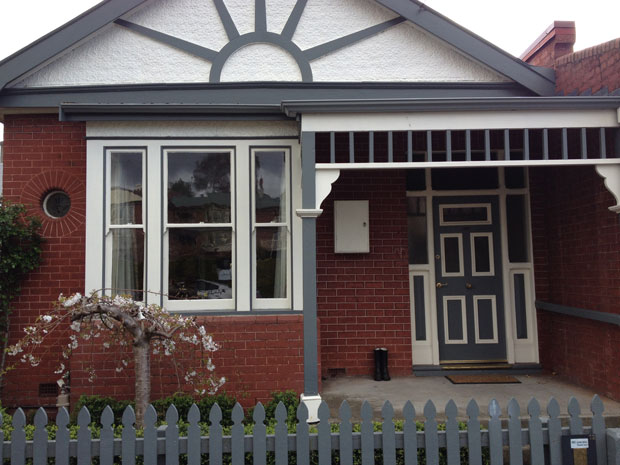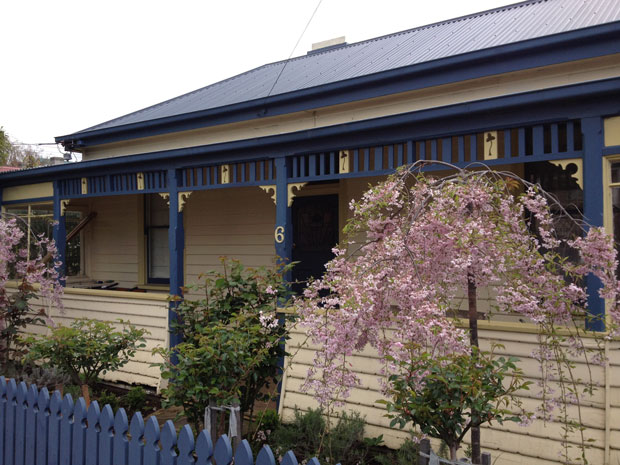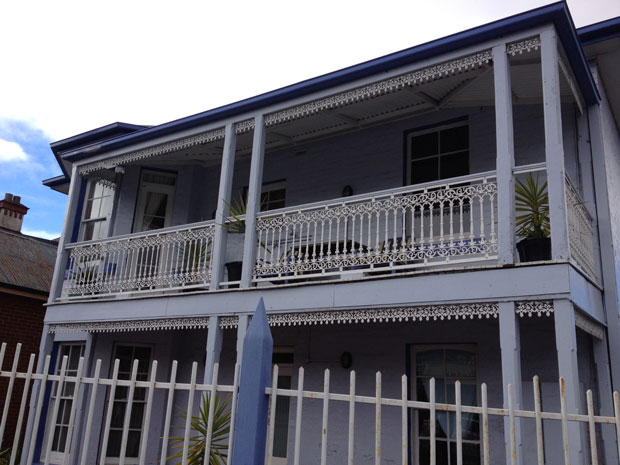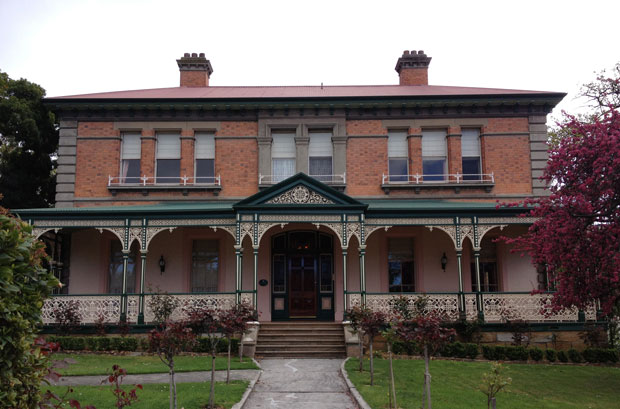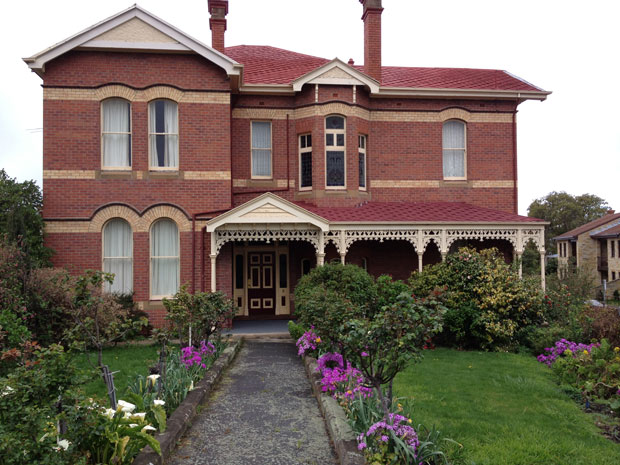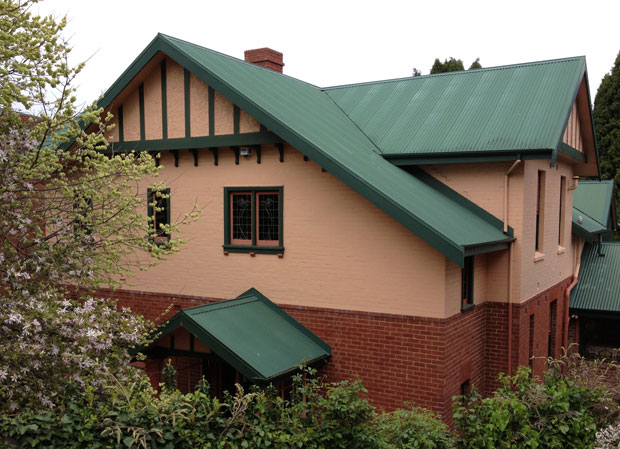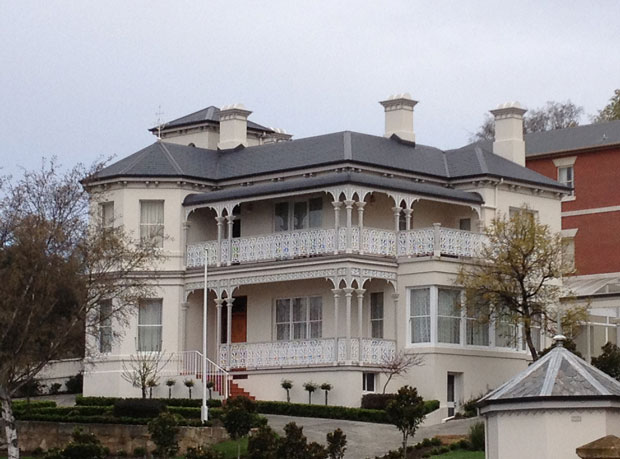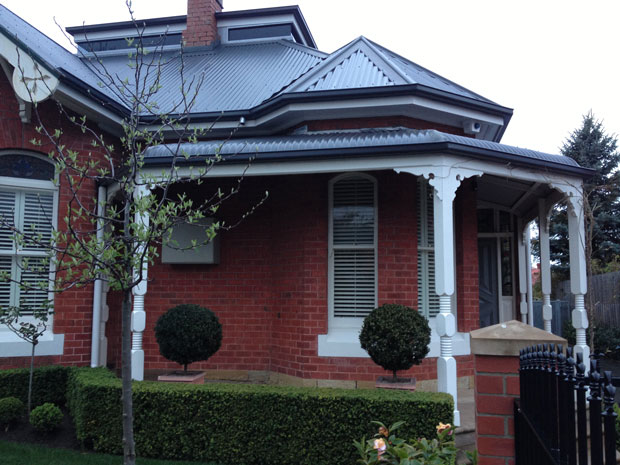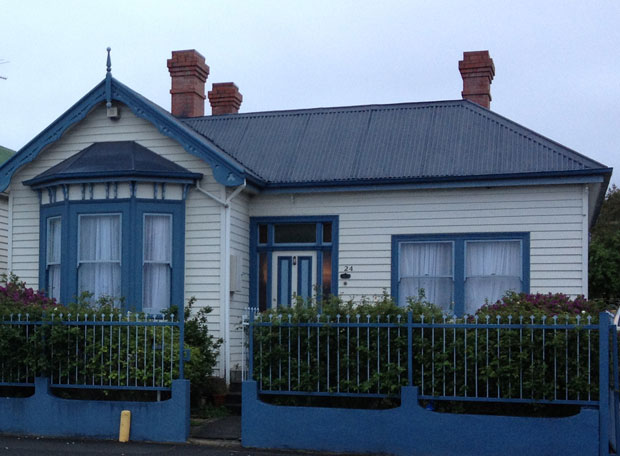Today we walked the length and breadth of inner Hobart so we saw a lot of houses. They are mostly made of brick and clapboard and are often brightly coloured with wrought iron lacework. Many have little picket fences and since it’s spring, they all have flowers.
Category Archives: Australia
Coles Bay and Bicheno, Tasmania
Our Launceston home exchange hosts have a house in Coles Bay on the east coast of Tasmania where we are spending three nights. We have the most marvellous view of the Hazards (1590 feet)
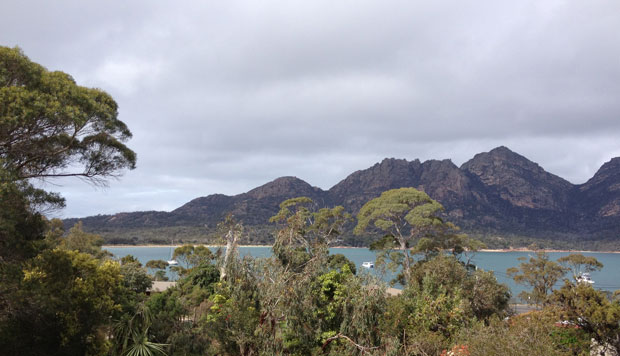
Yesterday morning, we went for a one-hour walk along the beach to Freycinet Lodge and saw the famous red stones you see in all the photos of the area.
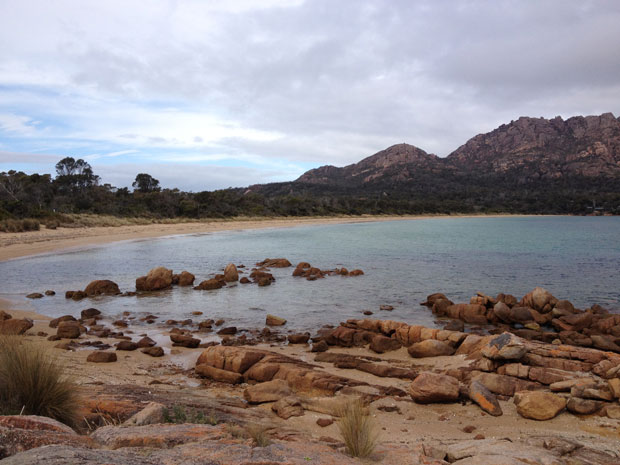
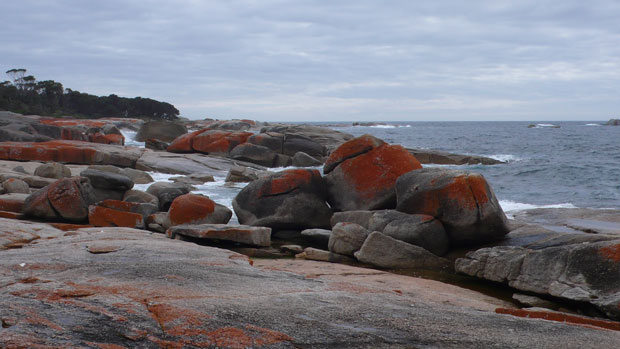
Today we went to Bicheno, about 35 K away, once the home of whalers and sealers and famous for its penguins but you only see them at dusk and have to go on a special tour. So we went to visit the Blow Hole instead.
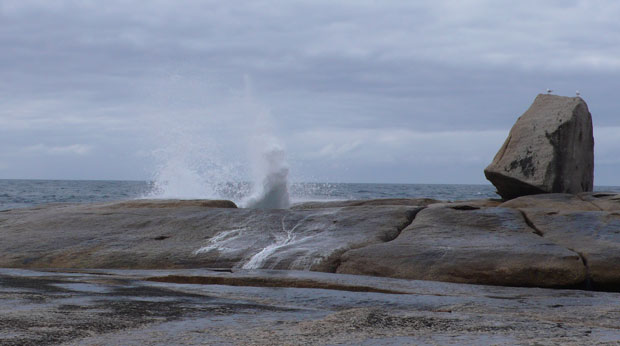
After that, we went to the Gulch, which is a little fishing port, and bought some fresh deepsea fish whose name I unfortunately can’t remember!
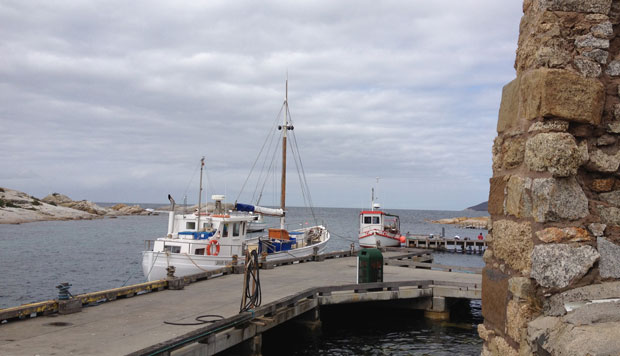
We then decided to drive north a bit and came to East Coast Nature World. We debated whether or not to go in and didn’t regret our choice. I had never seen a Tasmanian devil and certainly not two curled up together in the sun after a big feast on dead possum!

There were also lots of very tame wallabies and kangaroos, including one with a cute little joey sticking out of her pouch.
Not to mention this stunning pheasant imported from Asia.
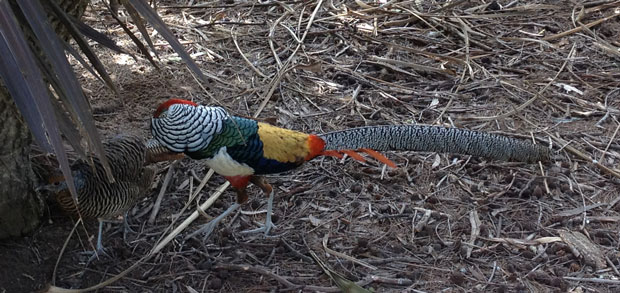
We then went back to Bicheno to have lunch at the Sea Life Centre and soak up its stunning views of the white sandy beaches and turquoise water. We had freshly caught white head (?) and a glass of sauvignon blanc from Springvale vineyards which was our next visit.
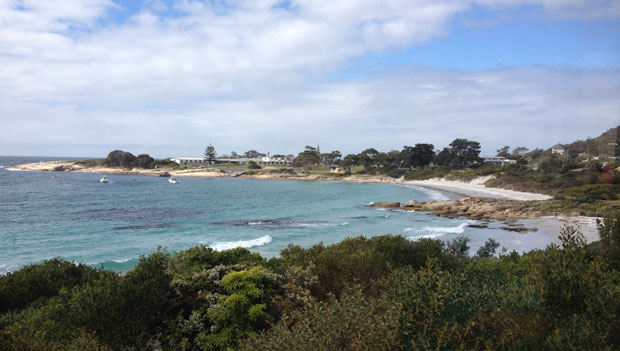
At Springvale, recommended by friends, we tasted their two pinot noirs, both pleasant, one oaked (2009) the other not (2012). Relationnel ordered one of each, not realising he waslooking at the 1/2 bottle prices. The full bottles cost 25 and 40 dollars. Gulp!
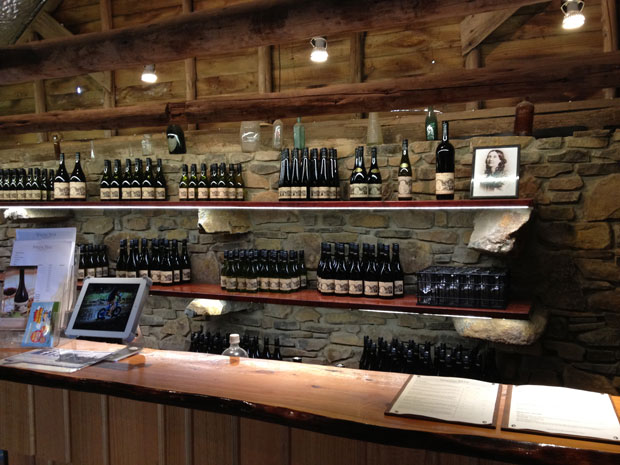
Old is Relative
Here I’ve been, for the last six months, vaunting my 400-year old house in the Loire Valley and I arrive in Tasmania which has some of the oldest buildings in Australia. The trouble is, most of them look just like the buildings in the centre of Townsville where I grew up and the oldest date from the early 1800s. I must confess that it’s a bit hard to get excited about houses that are not even 200 years old.
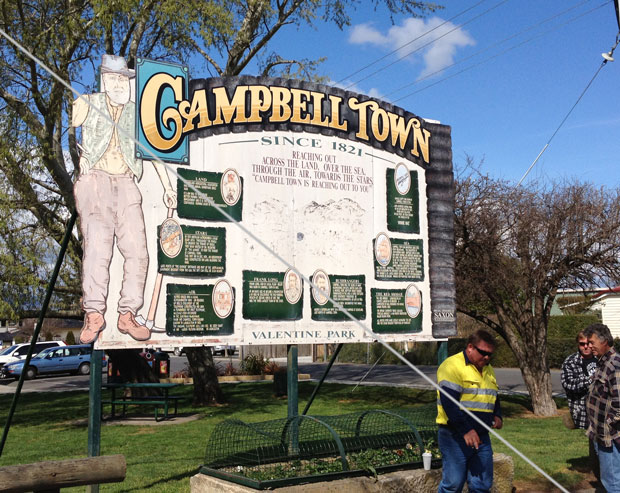
On our way from Launceston to Coles Bay, we stopped to get some lunch at Campbell Town, in the heart of Tasmania, established by Governor Macquarie in 1821, (population 800). We went past a place selling R.M. Williams clothing. Last time we were in Australia, Relationnel bought a shirt of that brand and we love the quality, so we went in. The young man in the shop looked about 16. He didn’t seem to have any idea where the shirts were to be found and the sizes seemed to be all mixed up.
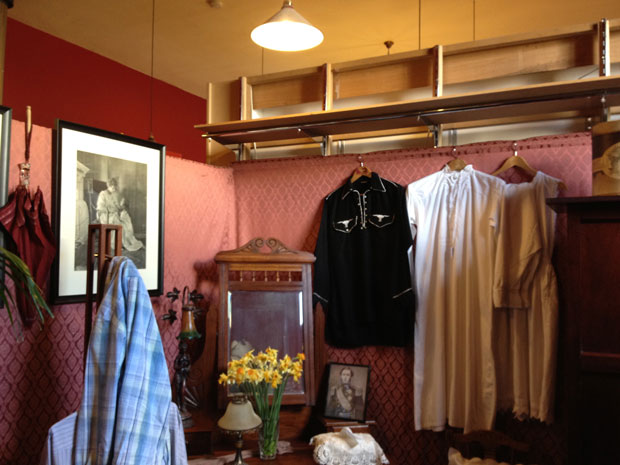
Most of the shirts were Stockyard, but he didn’t think to explain that it was the same brand. They were having a sale – 120 dollars for two Stockyard shirts. It took a lot of rooting around to find two Ms that we liked. What we loved was the changing room which looked like something out of a film. It seems the shop was once a grocery store.

As we left the shop we noticed a line of paving stones, with the names and details (crime, year, punishment) of the local convicts. We also passed an “Antiques and collectables” shop selling my mother’s old sewing chair for 12o dollars. I could make a fortune selling my Henri II furniture!
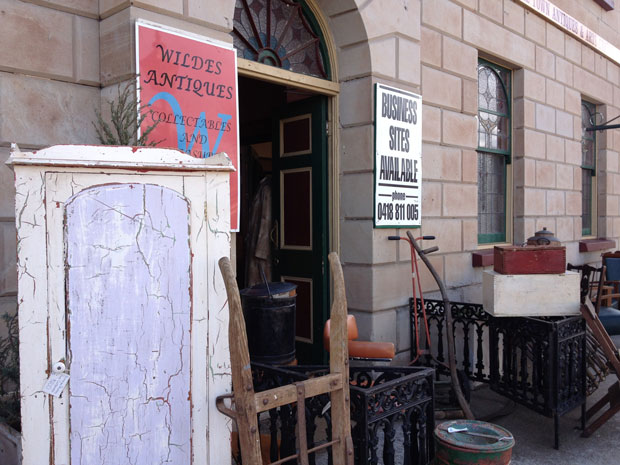
We crossed the road and I saw a church for sale. Now that’s an unusual piece of real estate! At the supermarket where we bought some coleslaw (we are pining for salad and vegetables in adequate amounts), I asked the lady at the check-out if there were any interesting villages to visit in the neighbourhood and she directed us to Ross (population 300) about 12 or 13 kilometers along the highway.
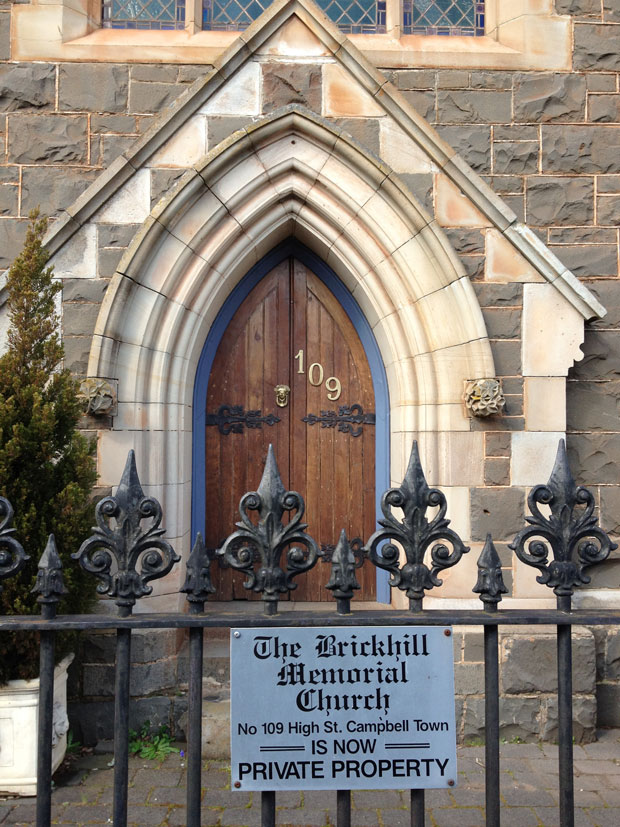
I consulted the Lonely Planet which was rather scathing I thought : “Another tidy (nay, immaculate) Midlands town … These days Ross’ elm-lined streets are almost gagging on colonial charm and history.” Not very encouraging , I thought. I was therefore very surprised to find a sleepy little town with hardly a soul in sight. Maybe the L.P. people don’t travel in early spring. We had our lunch at a picnic table near an old school which I initially thought was a church.
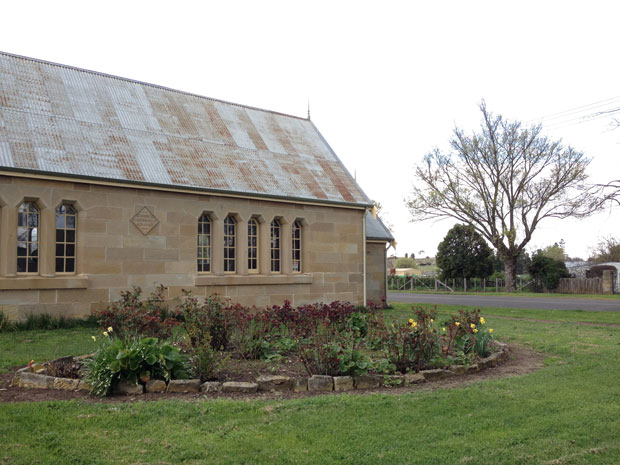
As it was starting to spit, we set off for the 3rd oldest bridge in Australia, which was a bit of a come-down (I was somehow expecting something bigger) but still very pretty with its intricate carvings sculpted by one of the two convict stone masons that built it in 1836. I was pleased to hear they were pardoned for their efforts.
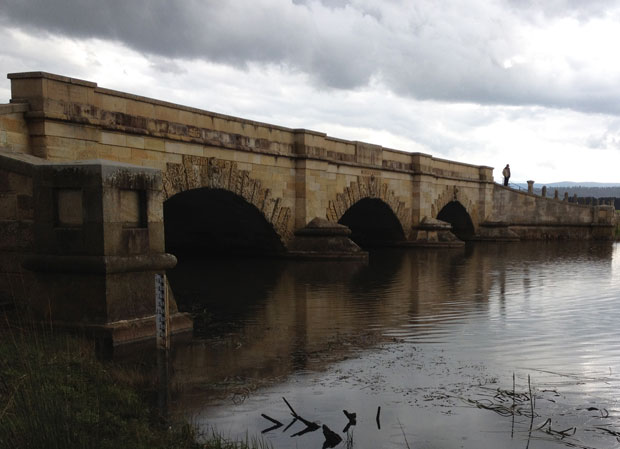
We walked up to the Uniting Church on top of Church Street hill with its panoramnic view of the surrounding countryside (that’s were we should have had lunch!), then took the Heritage Walk down past the Ross Female Factory.
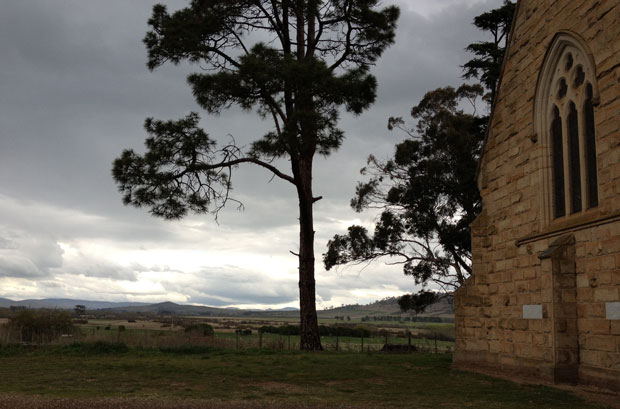
This was one of Tasmania’s two female prisons, operational between 1848 and 1854. I find it hard to imagine there were still convicts in those days. It was open for viewing so I lifted the latch and walked inside. Only two buildings remain, the assistant superintendant’s and overseer’s cottages.
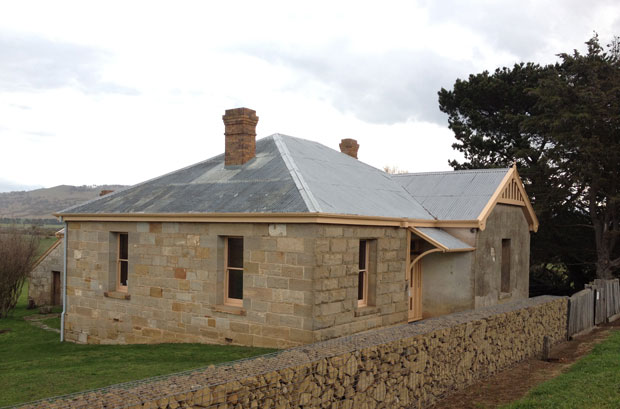
The site was both a factory and hiring depot, as well as an overnight station for convicts travelling between settlements. Because of the fresh air, it was also a lying-in hospital and nursery. I reckon the mothers and babies must have been pretty cold. I certainly was. Posters on the wall trace the history of some of the inmates. We got back to the car just before the rain started in earnest.
Wine Tasting in Tassie
Our four days in Sydney were spent catching up with family and friends, some of whom we hadn’t seen for 3 years, which was wonderful but exhausting particularly since we arrived a day later than I had expected which meant quite a bit of rescheduling. We left for Tasmania on Monday morning.
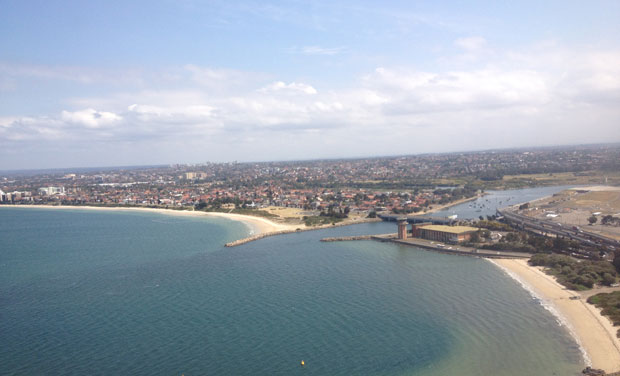
The plane left about an hour late but we made up for some of the lost time between Melbourne and Launceston. It was rainy and cold when we arrived at our home exchange in Riverside. It has a wonderful view of the River Tamar which it was difficult to fully appreciate because of the weather.
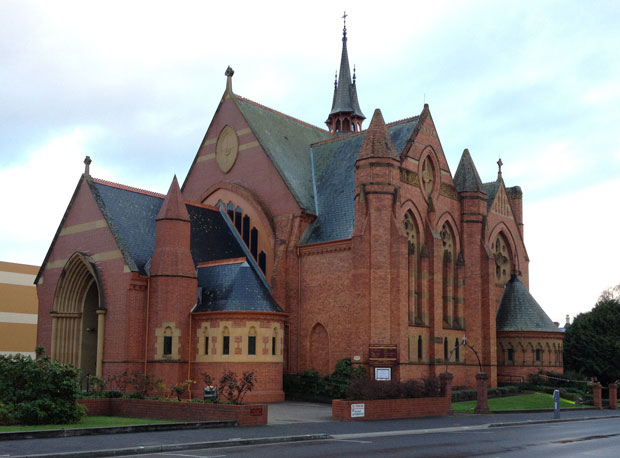
We drove into the city centre in our smart home exchange car with its built-in GPS. However, as I mentioned yesterday, we were amazed to discover that the shops are all closed by 5.30 pm. So much for food shopping. So we ate at Fish n’ Chips on Seaport Boulevard but thought it was very expensive and nothing out of the ordinary. The other restaurant was more upmarket. So a rather gloomy day in all.
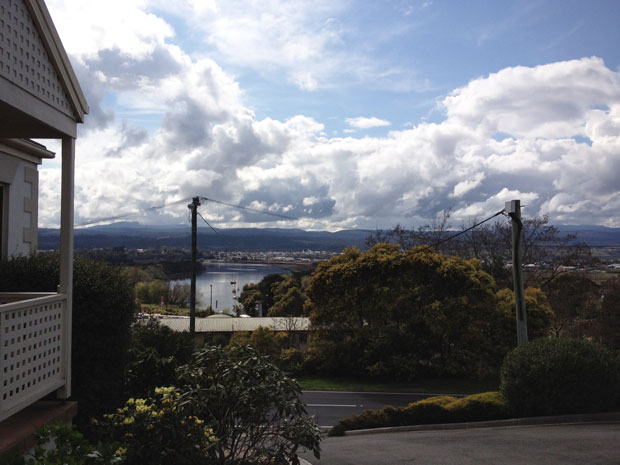
When we woke up this morning the world had taken on a new light. It was sunny! We could appreciate the stunning view the start with. We went into town to have breakfast at Elaia Café where we sat outside and ate our bacon and eggs with great gusto (you can’t buy regular bacon in France). We parked in a side street with the prettiest little houses.
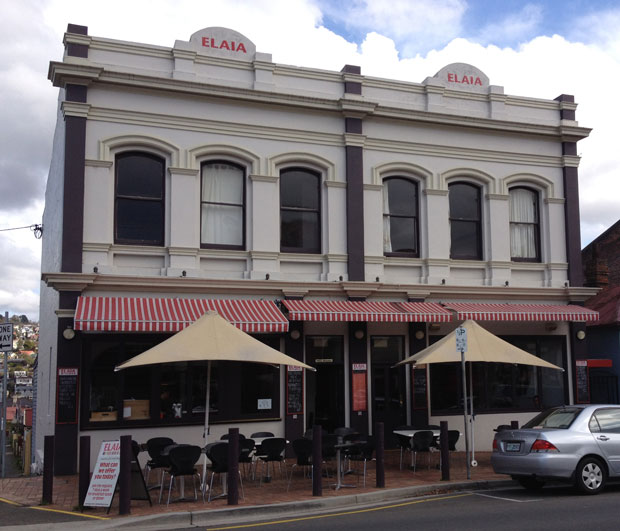
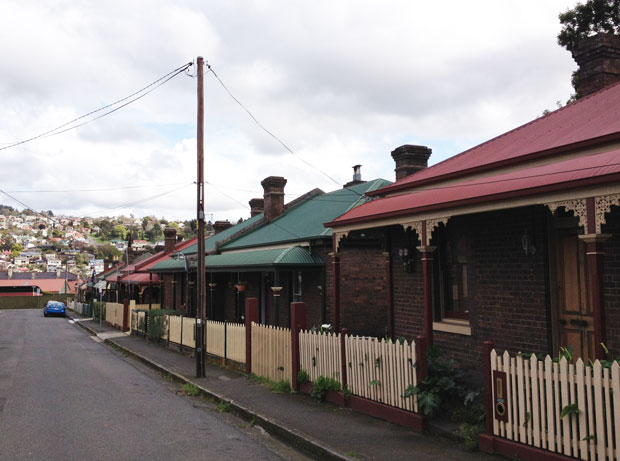
Our next stop was a wine tasting at Vélo on West Tamar Highway. I had read about the vineyard in a magazine cutting sent by our friends in Canberra whom we went with on a wine tour to Young and Orange last time we were in Australia. Michael, the vineyard owner, is one of Australia’s leading cyclists, having participated in the Moscow Olympic Games in 1980 and competed in Tour de France and Giro d’Italia.
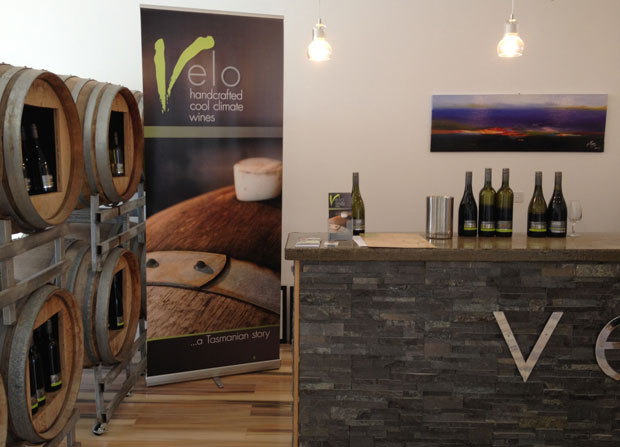
During that time, he and his wife Mary lived in France and Italy where they fell in love with wine. About 10 years ago, they bought one of Tasmania’s oldest vineyards, planted in 1966 by Graham Wiltshire. They named their vineyard Vélo, which means bike in French. It was Mary who looked after us at their cellar door with its wonderful view of the Tamar Valley.
She was busy with other customers when we arrived so had the time to hear us speaking French. Relationnel was delighted when she said “bonjour”. Although a little hesitant at first, she was able to present the different whites we wanted to try and I just supplied the missing vocab from time to time. We began with a sauvignon blanc, followed by a riesling (as we’d mentioned oysters), a pinot gris and an unwooded chardonnay with a surprising lychee nose.
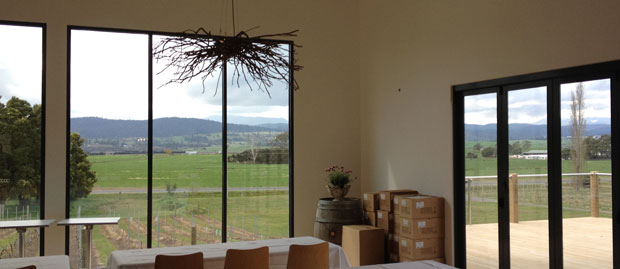
We chose the well-structured riesling and the pinot gris, with its elegant mineral nose and long finish, both 2010. They were not cheap by our standards at 25 dollars a piece, but then nothing is cheap for us at the moment now that the euro and dollar are practically on a par. They were our first experience of Tasmanian wines and we found them to be of excellent quality and very well-finished.
An excellent start to our first real day of holidays!
Feeling like a foreigner in my home country
Each time I go back to Australia, I feel more like a foreigner and less like an Australian. Although I have dual nationality, I don’t really consider myself to be French, despite the fact that I have lived there 37 years. The trouble is, I still have my Australian accent so people expect me to know how things work and to act like one of the natives.
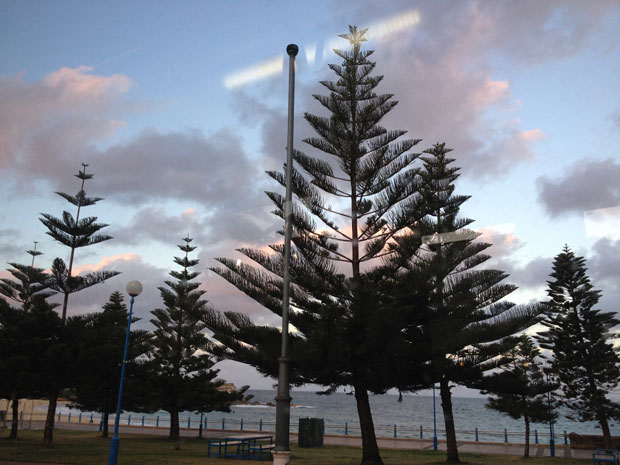
I don’t know the coins to start with. Our one and two euro coins are more or less the same size but the two euro coin has two colours so is easy to distinguish. The two dollar coinn however, is much smaller than the one dollar piece. Very confusing. I can still remember the pounds, shillings and pence which disappeared in 1966! And those dollars used to be much cheaper in the past as well. Now they are almost worth a euro!
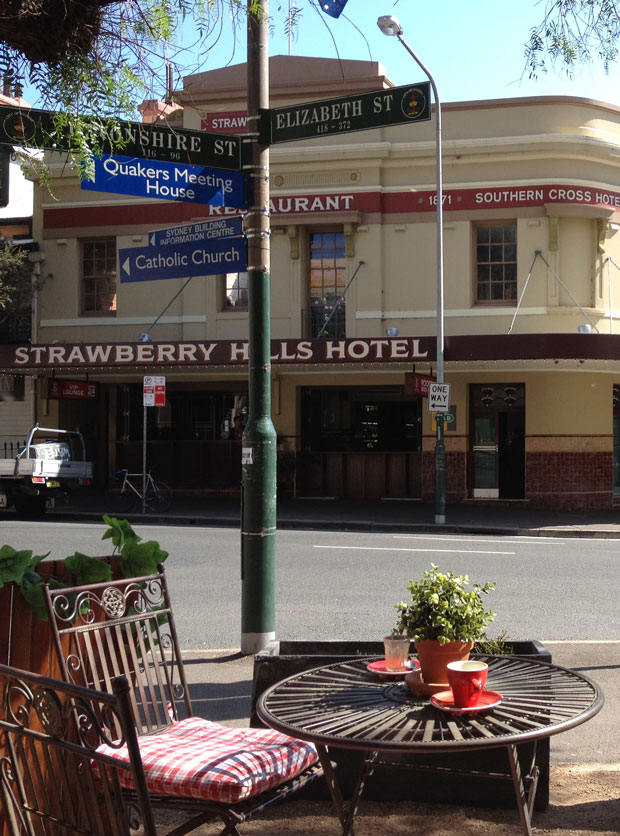
I can’t always understand what people are saying either. The other day, I bought two wraps (a new word in itself) in a tiny terrace café in Redfern and was asked “justhose?” “I’m sorry I don’t understand”, I replied. “Do you want anything else ?” Oh, I realised, he must have said “just those ?” I wasn’t expecting him to say that.

When we were taking the train to Brainy Pianist’s the other day, we couldn’t get the train vending machines to work so we just stood back and watched the next person. It turned out we were putting the money in the wrong machine – we didn’t realise there were two different ones, one of which said EFTPOS, not that I know what that means. Which leads to another difficulty – they have all sorts of strange abbreviations these days.
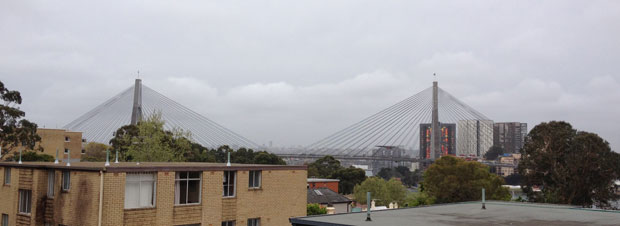
Would you believe that you don’t “go into town” any more but into the CBD or Central Business District. We just went into the Launceston CBD today and were stunned to find that all the shops were already closed at 5.30 pm (which explained why the parking metre was free – I initially thought it was just something else we didn’t understand. Only a news store (which didn’t have any more maps so was of no use whatsoever) and a pharmacy were open plus a couple of travel agents. We did see a Batman number plate on a Suburu though. How can you have a Batman number plate on a car?
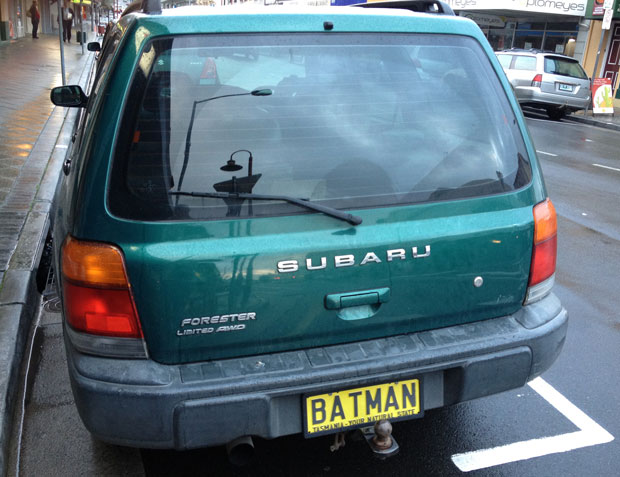
I guess it will gradually get better but I think it would be a whole lot easier if I didn’t sound like an Aussie !
I’ve Joined the Kindle Community!
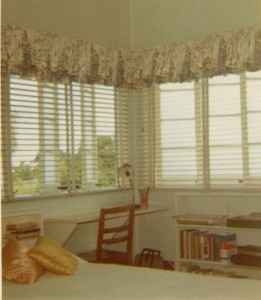 I’ve always been a ferocious reader. I had the great fortune to have a father who let me read absolutely anything I wanted from both his own library and the town library (he had to sign a paper saying that I could take books from the adult section when I was still a child) and who encouraged me to use a dictionary. I’d be lying in bed reading at night and call out hopefully “Dad, what does ‘testimony’ mean” and he’d inevitably reply, “Look it up in the dictionary”. So I’d take my trusty Pocket Oxford from the bedhead behind me and look it up.
I’ve always been a ferocious reader. I had the great fortune to have a father who let me read absolutely anything I wanted from both his own library and the town library (he had to sign a paper saying that I could take books from the adult section when I was still a child) and who encouraged me to use a dictionary. I’d be lying in bed reading at night and call out hopefully “Dad, what does ‘testimony’ mean” and he’d inevitably reply, “Look it up in the dictionary”. So I’d take my trusty Pocket Oxford from the bedhead behind me and look it up.
As a result, I grew up knowing the real meaning of words and how they are used. And I love words. I loved the Latin at church and I adored learning French at school. And my love of reading has never left me. I remember the very first book I ever read – an abridged version of Peter Pan. I think it probably shaped my whole life. I was fanatical about the Pollyanna series and read and reread them constantly. There was also Anne of Green Gables and Little Women, What Katy Did and The Bobbsey Twins, The Secret Seven and The Famous Five. But I soon left them behind for Gone with the Wind and Anna Karenine.
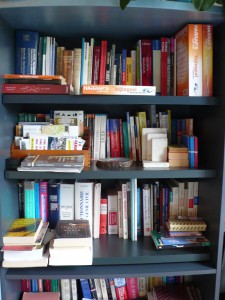 Dad had the complete collection of Maupassant’s short stories and novels (in English of course) which I devoured. How much I really understood I don’t know, but it introduced me to the fascinating world of France. My love of literature and French led me to an Arts degree with French honours despite my mathematical leanings and I was overjoyed when I came to France to discover that such a thing as a technical translator existed. I went on to get a masters in translation at ESIT in Paris and have been a freelance technical and legal translator ever since. What a wonderful excuse to have a bookshelf full of dictionaries of every kind!
Dad had the complete collection of Maupassant’s short stories and novels (in English of course) which I devoured. How much I really understood I don’t know, but it introduced me to the fascinating world of France. My love of literature and French led me to an Arts degree with French honours despite my mathematical leanings and I was overjoyed when I came to France to discover that such a thing as a technical translator existed. I went on to get a masters in translation at ESIT in Paris and have been a freelance technical and legal translator ever since. What a wonderful excuse to have a bookshelf full of dictionaries of every kind!
One of my big problems has always been to find enough books to read particularly on a reduced budget when my children were small. Libraries obviously solved the problem for French books. I also made the wonderful discovery that my beloved Russian novelists translate much better into French than into English. Fortunately I found a library nearby which had a good collection of English novels so I reread all the classics. My taste in reading is very eclectic and I’ve always loved rooting around in other people’s libraries to see what I can find. I’ll read anything that someone recommends.
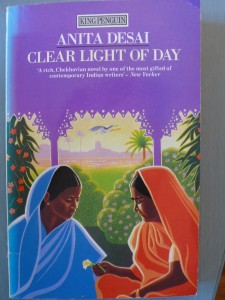 When I began teaching translation at ESIT, I started swapping books with my students. With the coming of Internet, especially sites like the Book Directory and Amazon where you can get the latest novels (well practically) without having to pay postage, my access to books changed dramatically. I can talk to my aunt in Australia about what she’s reading, order her suggestions off the Net and receive them within a couple of days! When we moved into Paris, I found a wonderful source of second-hand English books at Book-Off on rue Saint Augustin. AT 2 or 3 euros a time, I can fill my carry bag. They also buy the books back again (at 20 centimes!) thus eliminating the problem of where to put all these books once I’ve read them.
When I began teaching translation at ESIT, I started swapping books with my students. With the coming of Internet, especially sites like the Book Directory and Amazon where you can get the latest novels (well practically) without having to pay postage, my access to books changed dramatically. I can talk to my aunt in Australia about what she’s reading, order her suggestions off the Net and receive them within a couple of days! When we moved into Paris, I found a wonderful source of second-hand English books at Book-Off on rue Saint Augustin. AT 2 or 3 euros a time, I can fill my carry bag. They also buy the books back again (at 20 centimes!) thus eliminating the problem of where to put all these books once I’ve read them.
But there I was the other night, wandering aimlessly around, sifting through my bookcase and wondering what on earth I could find to read. I was sure I had a whole stack of unread books on a shelf somewhere. Sadly, that was not the case. I finally found Anita Desai’s Clear Light of Day which I had totally forgotten and am thoroughly enjoying.
But now, thanks to Leonardo, I have a Kindle with international 3G so will never be short of reading material EVER AGAIN – provided I remember to charge it of course!
The Sydney Writers’ Centre’s Best Australian Blogs 2012
You may be wondering what the Best Australian Blogs 2012 and Vote for Me Now badges are doing on my blog. Well it’s a competition run by the Sydney Writers’ Centre and I have been kindly nominated by a fellow blogger. I’m competing with an impressive 1023 other Australian bloggers!
Bloggers are understandably judged on the quality of their writing (70%), presentation and usability (20%) and engagement and social media integration (10%). The judges will be looking at conversations in the comment section, guest bloggers, and the use of social media to promote the blog. So if you haven’t already “liked” my Facebook page – http://www.facebook.com/AussieFrance – this is the time to do so!
There’s also a People’s Choice round which is now open. Voting is unrestricted (you don’t have to be Australian) so if you enjoy reading my blog, feel free to vote for me! It’s very easy and only takes a second. Just follow the instructions below:
1) Click here or on the badge (www.surveymonkey.com/s/BAB2012 in case you have a problem).
2) Scroll down the first page until you find Aussie in France (the list is in alphabetical order)
3) TICK the box for Aussie in France (of course)
4) Click NEXT 5 times (voting for others on the way if you want)
5) Leave your name and email address
6) Click NEXT one last time and it’s finished.
If you’d like to tweet about your vote, the hashtag is #bestblogs2012.
The winner of the People’s Choice Award will be announced on Thursday 10 May 2012.
And while we’re on the subject of blogs, I’d like to thank all my readers for their comments and encouragements since my first post on 14th October 2011 about Leonardo Leaving the Nest. I’m not only able to give vent to my creative energies but also meeting new people across the globe who share the same interests as I do! I love meeting other bloggers as well – something I never expected.
Taking the Train to Paris Like A Real Provincial
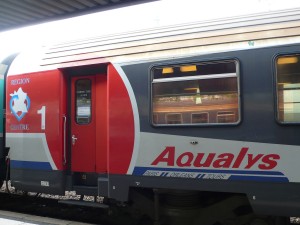 This is my first experience of commuting to Paris from Blois. I have to go up to teach a double class at uni today. I’ve discovered I can take two types of trains – TER and TGV. The first is quite cheap – 26 euros – while the second is a lot more expensive. I’m meeting up with Relationnel in Tours on the way back so we can buy a Henri II desk we saw in leboncoin.com and since my class doesn’t finish until 5 pm, I’m travelling in peak hour, which is costing me a wacking 59 euros. I could take a later train but that would mean waiting around in Paris and it would be too late to get the desk.
This is my first experience of commuting to Paris from Blois. I have to go up to teach a double class at uni today. I’ve discovered I can take two types of trains – TER and TGV. The first is quite cheap – 26 euros – while the second is a lot more expensive. I’m meeting up with Relationnel in Tours on the way back so we can buy a Henri II desk we saw in leboncoin.com and since my class doesn’t finish until 5 pm, I’m travelling in peak hour, which is costing me a wacking 59 euros. I could take a later train but that would mean waiting around in Paris and it would be too late to get the desk.
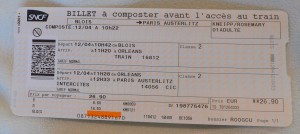 You can’t reserve a seat on the TER (I have to change in Orléans anyway) but since I didn’t leave until 10.42 (I love the way the times are so precise), there were plenty of places. I do have a reservation on the TGV though – it’s compulsory. I bought both tickets over the Internet on www.sncf.fr. For the TER, I had to put my VISA card in the ticket machine at the station to have the ticket issued. I immediately put it in the puncher because I often forget and suddenly realise in the train that it isn’t « composté » as they say in French.
You can’t reserve a seat on the TER (I have to change in Orléans anyway) but since I didn’t leave until 10.42 (I love the way the times are so precise), there were plenty of places. I do have a reservation on the TGV though – it’s compulsory. I bought both tickets over the Internet on www.sncf.fr. For the TER, I had to put my VISA card in the ticket machine at the station to have the ticket issued. I immediately put it in the puncher because I often forget and suddenly realise in the train that it isn’t « composté » as they say in French.
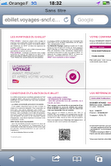 The TGV reservation is quite different. I have to print out an e-ticket and show it to the inspector on the train when he comes around. I have a new printer back in Blois that I haven’t set up yet. I started to look into it this morning but I couldn’t follow what the little drawings were telling me to do. I’ll have to get Relationnel onto it during the weekend. I much prefer written instructions that I can understand. So I’ll ask the nice secretary at my uni to print it out for me. I just mustn’t forget! You’d think I could have it on my iPhone the way they do for boarding passes but I couldn’t see any options indicating that on the Internet.
The TGV reservation is quite different. I have to print out an e-ticket and show it to the inspector on the train when he comes around. I have a new printer back in Blois that I haven’t set up yet. I started to look into it this morning but I couldn’t follow what the little drawings were telling me to do. I’ll have to get Relationnel onto it during the weekend. I much prefer written instructions that I can understand. So I’ll ask the nice secretary at my uni to print it out for me. I just mustn’t forget! You’d think I could have it on my iPhone the way they do for boarding passes but I couldn’t see any options indicating that on the Internet.
The problem is that I don’t really like trains. I don’t know why. I’m always afraid I’m going to miss it or get out at the wrong place or something. The first time I took a train, I was about 20. A friend and I took the Sunlander from Townsville to Brisbane, then from Brisbane to Sydney on our way to Noumea. I think it took about 48 hours in all. The first train was a steam engine if I remember correctly. Maureen’s mother had made boiled fruit cake and all sorts of goodies so we did a lot of eating on that trip.
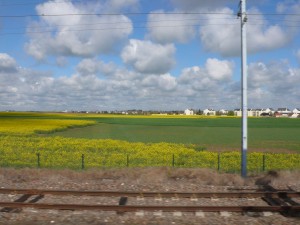 The train from Brisbane to Sydney was far more chic and we had a compartment of our own with a toilet and shower. Not like the Sunlander with its open toilets that you couldn’t use in the station! Trains are far more popular in France and, on the whole, are efficient and on time (except when there are strikes of course, but that’s almost a national hobby). Having said that, we left Orléans 10 minutes late but I had plenty of time to take a photo of the rape fields. At least today I don’t have any luggage, just my trusty laptop, even though it’s a bit heavy to lug around.
The train from Brisbane to Sydney was far more chic and we had a compartment of our own with a toilet and shower. Not like the Sunlander with its open toilets that you couldn’t use in the station! Trains are far more popular in France and, on the whole, are efficient and on time (except when there are strikes of course, but that’s almost a national hobby). Having said that, we left Orléans 10 minutes late but I had plenty of time to take a photo of the rape fields. At least today I don’t have any luggage, just my trusty laptop, even though it’s a bit heavy to lug around.
I’m now in the TGV and it seems I could have clicked on “Download” on the email on my iPhone instead of printing out the ticket. I’ll know for next time!
Favourite Paris Wine Shops – Phone App: Google Translate – Creating a Healthy French Pantry
Where to buy wine in Paris, a helpful traveller’s phone app and healthy eating the French way are the subjects featured in my Wednesday’s Other Blogs this week. Thank you to Like Home in Paris (vacation apartment rentals in Paris), Femmes Francophiles (fellow Australian blogger with an ongoing passion for France and the French language) and Mademoiselle Slimalicious (a young Sydney-based French blog writer who promotes healthy eating, fitness and exercise based on the principles of the French Paradox).
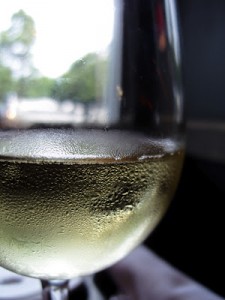 Sipping on Saturday – Favourite Paris Wine Shops
Sipping on Saturday – Favourite Paris Wine Shops
from Like Home in Paris
I know who I go to ask when I have a wine question or can’t decide which glass to take – Preston Mohr, that’s who. Our favorite drinking partner tells us about his favorite wine shops in Paris and believe me you’ll want to take note. Read more
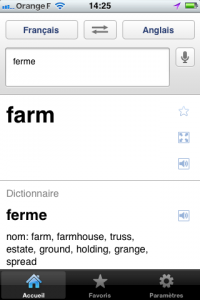 Phone Application: Google Translate
Phone Application: Google Translate
from Femmes Francophiles
Translation apps are a growing market. No longer do we need to fossick in back packs or handbags for our bilingual dictionary or phrasebook. No doubt there are now young international travellers who have never had to worry about the weight associated with carrying these books with their dog-eared pages. Read more
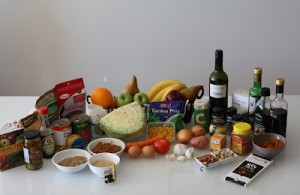 Creating a Healthy French Pantry
Creating a Healthy French Pantry
from Mademoiselle Slimalicious
Cooking at home (rather than ordering take-away) enables you to be fully in control of what you eat by being aware of the nutritive value of your meals. In order to manage your weight efficiently (the way French women do), it is important to make cooking everyday one of your priority. Read more.
Daylight Saving in France
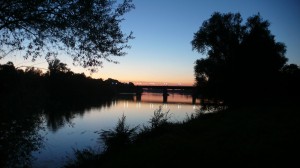
I do, of course, love the long summer days when it stays light until 11 pm. Cycling after dinner is particularly attractive. What I don’t like is the actual changeover because it puts me out-of-kilter for at least a couple of weeks and I’m not a good sleeper at the best of times. Black Cat tells me that everyone in the metro was overly aggressive in the metro this morning because they all had to get up an hour earlier than usual! The changeovers take place around about 21st March and 21st October each year.
Relationnel never manages to remember whether he has to put his clock back or forward each time. In French they say “avancer” or “retarder l’heure” meaning “putting the time forwards or backwards”. Of course with all the electronic equipment we have these days, it’s much harder not to know about the changeover and miss a train or something though I noticed the clock on the car hadn’t changed yesterday.
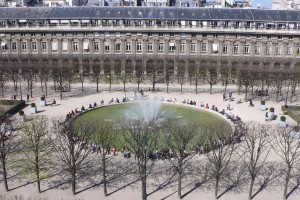
We’ve been having unseasonably warm weather too (not that I’m complaining!) which means that no one was very keen on going to bed an hour earlier than their biological clock last night either. I can remember how difficult it was to get the kids onto the new time when they were little. I even joined a lobby group in the hope that daylight saving might disappear altogether, but it didn’t do any good.
It all started of course for purely materialistic reasons. According to the French finance ministry, “Daylight saving (or l’heure d’été – summer time – as they say in French) was implemented in France in 1975 after the 1974 oil crunch with the aim of saving energy by reducing lighting, particularly in the evening. Today, it is estimated that 250,000 tonnes of oil equivalent (toe) are saved each year as a result of daylight saving in France”. So, there’s not much hope of a lobby group having any effect!
It seems that daylight saving goes back to Ancient Times and was resurrected by Benjamin Franklin in April 1784 in a well-known satire. The next person to promote the idea was New Zealand entomologist George Vernon Hudson. He was a shift worker and used to collect insects in his spare time so obviously wanted as much daylight as possible. He presented a paper to the Wellington Philosophical Society in 1895 proposing a two-hour daylight-saving shift. It didn’t catch on though until an Englishman,William Willet (poor man with a name like that), published a pamphlet in 1907 called “The Waste of Daylight”. He thought up this really complicated system of putting the clock forward by 80 minutes in 4 stages in April and then back again in September. No wonder it took another 9 years to be voted in by the British parliament, by which time poor Willet had died of the flu.
Ireland, Italy and France followed suit as did most of the other European countries after the War. But France did away with daylight saving in 1946 and didn’t bring it back until 1975, the year I arrived in France. Having been born and bred in North Queensland, I’d never experienced daylight saving before. Queensland is still holding out against the rest of the country but there’s a lot more lobbying these days, particularly by groups such as the The Daylight Saving for Southeast Queensland Party.
So now, Leonardo (who’s in Sydney) and I are 9 hours apart instead of 10. For the moment, I don’t know whether it’s better or worse.
And thank you, Wikipedia, for all the facts and figures!




